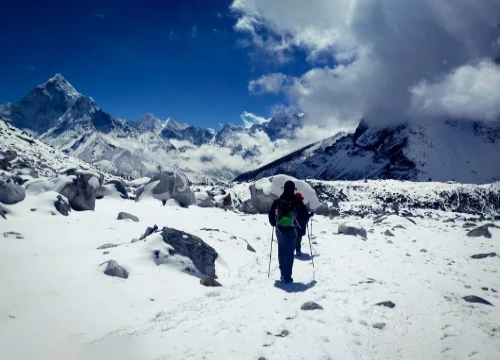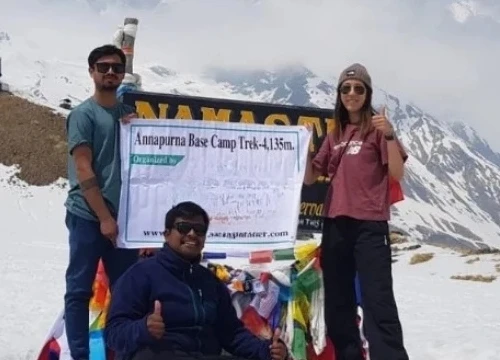Trekking in Nepal has deep roots that span centuries, but modern trekking—as we understand it today—truly began to take shape in the mid-twentieth century. Here’s a comprehensive look at how it all unfolded:
How did trekking started in Nepal?
Table of Contents
Ancient and Local Roots
For generations, the people of Nepal relied on rugged mountain trails as essential trade and pilgrimage routes. These pathways connected remote villages and facilitated the exchange of goods, culture, and ideas across the challenging Himalayan terrain. Although these journeys were not “treks” in a recreational sense, they laid the groundwork for the later fascination with Nepal’s landscapes.
The Birth of Modern Trekking in Nepal(1940s–1950s):
- 1949 – Bill Tilman’s Pioneering Expeditions: Modern trekking in Nepal is largely credited to British adventurer Bill Tilman. In 1949, Tilman obtained permission from the Nepali king to explore remote regions such as the Kali Gandaki, Helambu, and Everest areas. His expeditions opened previously inaccessible trails and showcased the enchantment of Nepal’s mountains, sparking international interest in the region.
- 1950–1951 – Mountaineering Expeditions and Early Explorations: Shortly after Tilman’s groundbreaking journeys, other prominent mountaineers began to explore Nepal’s high peaks. In 1950, Maurice Herzog led a French expedition to Annapurna, paving the way for the world’s first successful ascent of an 8,000-meter peak. Around the same time, American-led and British-led expeditions set their sights on Everest’s base and surrounding high-altitude areas, further establishing Nepal as a premier destination for mountain adventures.
Commercialization and the Trekking Boom (1960s Onward)
- 1964 – The Rise of Commercial Trekking: Recognizing the immense potential of Nepal’s stunning trails, retired Gurkha officer Colonel Jimmy Roberts leveraged his extensive experience in the region to pioneer commercial trekking. In 1964, he was instrumental in launching Nepal’s first trekking company, Mountain Travel. This company introduced the concept of guided treks with full support, including Sherpa teams, cooks, and porters—an innovation that transformed mountain trekking into a more accessible and comfortable experience for international travelers.
- Expansion and Modern Infrastructure: The success of early trekking ventures sparked a steady evolution in Nepal’s trekking industry. Over the following decades, improved roads, the establishment of teahouses, better communication networks, and reliable support services turned the once-arduous trails into structured routes. This growth not only made trekking safer and more comfortable but also opened the Himalayas to millions of adventurers from around the world.
Summary Timeline
Year/Period | Milestone |
Pre-1900s | Indigenous communities use mountain trails for trade and pilgrimage. |
1949 | Bill Tilman gains permission from the Nepali king to explore remote regions (Kali Gandaki, Helambu, Everest) – marking the birth of modern trekking in Nepal. |
1950–1951 | Maurice Herzog leads a French expedition to Annapurna in 1950; American and British expeditions follow, exploring high-altitude routes around Everest in 1950 and 1951. |
1964 | Colonel Jimmy Roberts founds Mountain Travel, launching the first commercial trekking expeditions in Nepal. |
Since these early days, trekking has evolved into one of Nepal’s most vital sectors, drawing adventurers from around the globe and playing a key role in the country’s cultural exchange and economic growth.
If you’re interested in more on how these early expeditions influenced the development of trekking routes or the specific challenges they faced along the way, feel free to ask!
For any queries:
+977-9818178630
Significant changes of trekking industry in Nepal in recent years
The trekking industry has undergone significant changes in recent years, driven by shifts in traveler preferences, sustainability efforts, and technological advancements. Here are some key trends shaping modern trekking:
Rise of Eco-Trekking and Sustainable Travel
- The demand for eco-friendly trekking has surged, with travelers prioritizing sustainability, conservation, and cultural immersion.
- Nepal’s eco-trekking market is projected to grow from USD 423.6 million in 2025 to USD 1.14 billion by 2035, reflecting a strong shift toward regenerative tourism.
- Treks focused on permaculture, forest conservation, and community-managed ecotourism have gained popularity, particularly in regions like Annapurna, Langtang, and Manaslu.
Luxury and Personalized Trekking Experiences
- High-end trekking has expanded, offering luxury lodges, private helicopter transfers, and customized itineraries for travelers seeking comfort alongside adventure.
- Trekking companies now provide bespoke experiences, blending adventure with wellness retreats, cultural immersion, and exclusive services.
Technological Advancements in Trekking
- The integration of cutting-edge trekking gear, GPS navigation tools, and digital booking platforms has improved safety and convenience.
- Online booking has become the dominant method, accounting for 31% of trekking reservations in 2022, making trip planning more accessible.
Increased Focus on Safety and Infrastructure
- Governments and NGOs have invested in trail rehabilitation, infrastructure improvements, and sustainability certifications for eco-lodges.
- Enhanced safety measures, including better communication networks and emergency response systems, have made trekking more secure.
Growth of Independent and Domestic Trekking
- Younger Nepali travelers are increasingly engaging in conservation-linked trekking, contributing to the rise of domestic adventure tourism.
- Independent trekking has gained traction, with more travelers opting for self-guided routes while relying on digital resources for navigation.
Challenges: Road Development and Environmental Impact
- Expanding road networks in trekking regions have altered traditional routes, sometimes disrupted the trekking experience and affected Nepal’s fragile ecology.
- Efforts to balance infrastructure development with environmental preservation remain a key focus for the industry.
Overall, trekking has evolved into a more diverse, sustainable, and technologically advanced industry, catering to a wide range of travelers—from eco-conscious adventurers to luxury-seeking trekkers. If you're interested in how these trends impact specific routes like the Annapurna Circuit.







